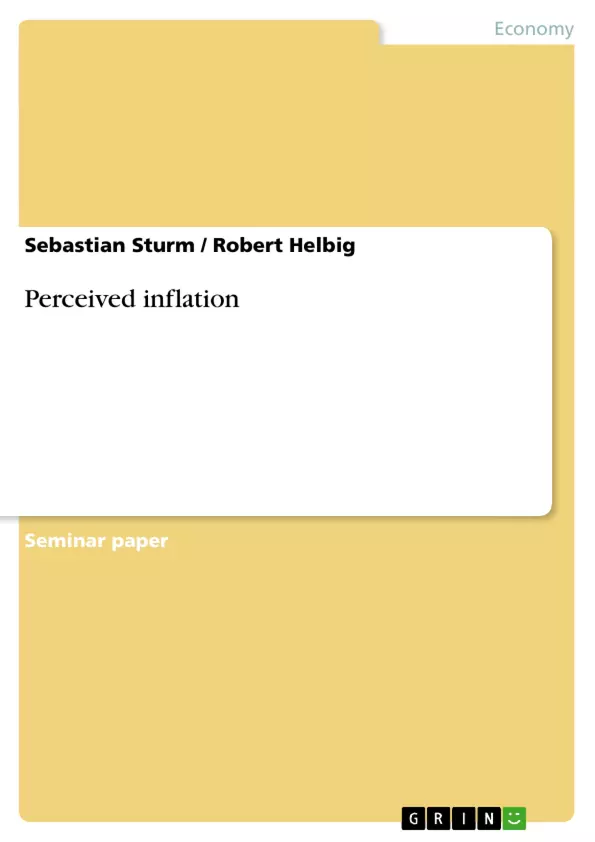The purpose of this paper is to give the reader an understanding of Brachingers new developed theory of perceived inflation. Additionally, Brachingers new developed Index of Perceived Inflation is introduced analyzed and critically reviewed. Therefore the term paper is structured as followed:
To understand the basic underlying of Brachingers theory, it is necessary to refer to the Prospect Theory, developed by Kahneman and Tversky in 1979. The main focus from Prospect theory is laid on its assumptions. In detail, the first section starts with a brief thought experiment. Afterwards the concept of reference dependency and loss aversion will be introduced.
The second part of this paper deals with Brachingers work on the theory as well as on the Index of Perceived Inflation. It is shown how Brachinger derived his index from the general Laspeyres formula by adjusting for several restrictions from the Prospect theory. This chapter closes by presenting Brachingers results of perceived inflation for Germany in comparison to the actual rate of inflation after the currency changeover.
The last part of this work deals with the criticism on Brachingers new developed theory. In particular, it is shown that Brachingers assumptions and simplifications are inappropriate to fully explain the phenomenon of perceived inflation. Moreover, it is illustrated that Brachingers results are inconsistent with empirical results. Finally, the paper ends up with alternative explanations which are probably capable to explain the inflation as perceived. Lastly, a conclusion is drawn which will sum up the results and the ability whether perceived inflation is revealed or not.
Inhaltsverzeichnis (Table of Contents)
- 1. Introduction
- 2. Methodology
- 3. A brief Introduction to Prospect Theory
- 3.1 A thought experiment
- 3.2 Reference dependency
- 3.3 Loss aversion
- 4. Brachingers Index of Perceived Inflation (IPI)
- 4.1 The consumer price index as a general Laspeyres type formula
- 4.2 Index of perceived Inflation (IPI)
- 4.3 Derivation of frequency weights
- 4.4 Perceived Inflation in Germany after the currency changeover
- 5. Criticism on Index of Perceived Inflation (IPI)
- 5.1 Assumptions adopted from the Prospect Theory
- 5.2 Additional Assumptions of the Index of Perceived Inflation
- 5.3 Comparison with the European Consumer Survey
- 5.4 Other effects on perceived inflation in 2002
- 6. Results and Conclusion
Zielsetzung und Themenschwerpunkte (Objectives and Key Themes)
This paper examines the phenomenon of perceived inflation in Germany following the introduction of the Euro. It specifically focuses on Wolfgang Brachinger's theory of the Index of Perceived Inflation (IPI), which aims to quantify perceived inflation. The paper explores the theoretical underpinnings of the IPI, based on Prospect Theory and other assumptions, and analyzes its strengths and limitations.
- Perceived inflation in Germany after the Euro introduction
- The Index of Perceived Inflation (IPI)
- Assumptions and limitations of the IPI
- Comparison of the IPI with other inflation measures
- Criticism and debate surrounding the IPI
Zusammenfassung der Kapitel (Chapter Summaries)
The introduction delves into the debate surrounding perceived inflation in Germany after the Euro's implementation. It highlights the discrepancy between official price indices and survey-based measures, leading to the development of the IPI by Wolfgang Brachinger. The paper outlines the aim of presenting Brachinger's theory and the criticism it has received.
Chapter 2 outlines the methodology used for developing the IPI. It draws on Prospect Theory, which explains how individuals perceive gains and losses differently. This chapter explores the concepts of reference dependency and loss aversion, which are crucial to understanding the IPI.
Chapter 3 focuses on the IPI itself. It begins with a detailed explanation of the traditional Consumer Price Index (CPI) and how it differs from the IPI. It then explores the construction of the IPI, highlighting its unique approach to calculating inflation based on perceived price changes.
Chapter 4 delves into the criticism surrounding the IPI. It examines the assumptions made based on Prospect Theory and the additional assumptions used in developing the index. The chapter also compares the IPI with the European Consumer Survey, providing insights into the validity of its results.
Schlüsselwörter (Keywords)
The key terms and concepts explored in this paper include: perceived inflation, Index of Perceived Inflation (IPI), Prospect Theory, loss aversion, reference dependency, Consumer Price Index (CPI), European Consumer Survey, Euro introduction, price rounding, German inflation, currency changeover, and economic survey data.
- Quote paper
- Sebastian Sturm (Author), Robert Helbig (Author), 2007, Perceived inflation , Munich, GRIN Verlag, https://www.grin.com/document/72467



